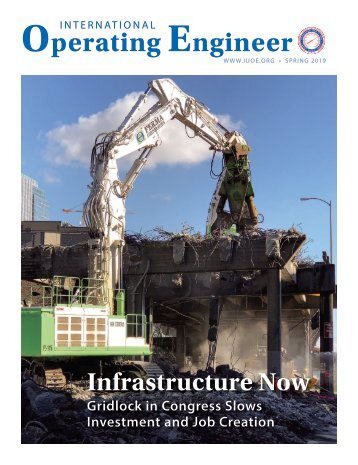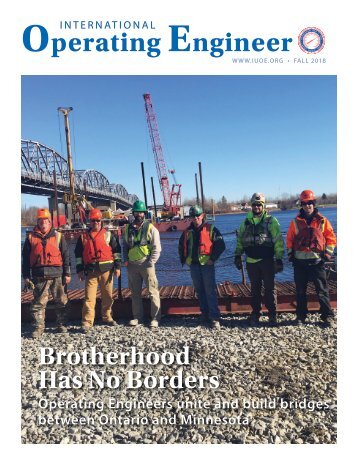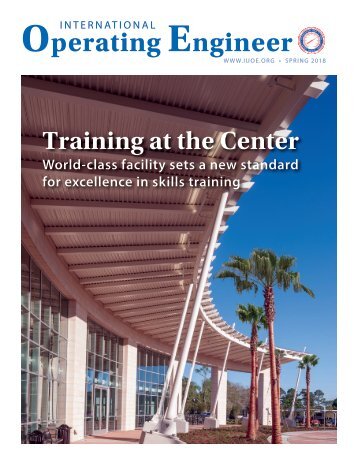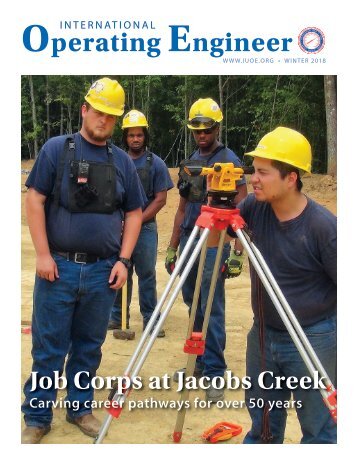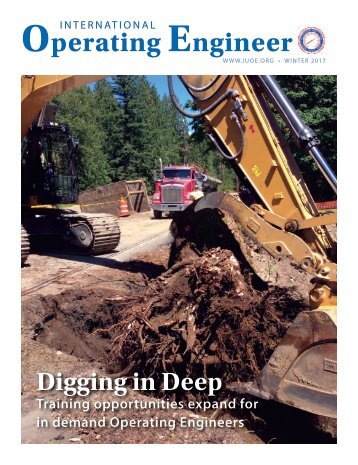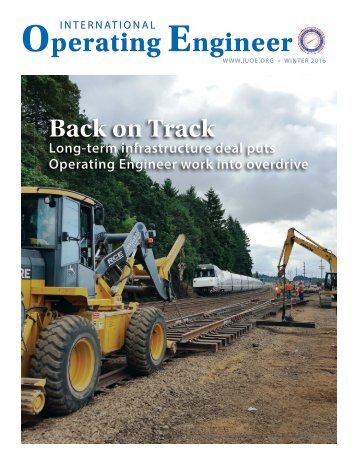International Operating Engineer - Winter 2019
- Text
- Operating
- Iuoe
- Engineer
- Engineers
- Corps
- Shutdown
- Workers
- Scabby
- Membership
Politics & Legislation
Politics & Legislation Federal Shutdown Leaves IUOE Members Locked Out of Work Labor Notes IUOE Grows, but Overall Union Membership Dips Slightly ON JANUARY 25TH, the White House and Congressional leaders agreed to end the longest government shutdown in U.S. history, which dragged on for 35 long days. The temporary agreement only keeps the government open for three weeks until February 15th when another shutdown could possibly occur. The shutdown affected approximately 800,000 federal employees. Nearly 500,000 contract workers of the federal government were also unable to work, including hundreds of Operating Engineers. Part way through the shutdown, direct federal employees were given assurances that once the government was reopened, they would receive back pay. Workers for contractors however, were not given a similar assurance, and they are unlikely to get any remuneration for that lost time on the job. It was essentially a lockout by the federal government. Workers unexpectedly without work had to figure out how to pay their bills and provide for their families while missing two consecutive paychecks. Many federal employees, from the FBI to the TSA, were still required to report to work as they were designated essential workers. IUOE members were not immune from the shutdown. Local 99 (Washington, D.C.) members felt the brunt of the dysfunction in the federal government. The Local had members laid off in workplaces across their jurisdiction, with the biggest unit being affected at NASA complexes. The shutdown had other unintended consequences as well. While the government was shut down, permitting agencies did not have staff to issue permits on many construction projects which employ Operating Engineers. For example, the Draft Environmental Impact Statement (DEIS) for the Jordan Cove LNG project in Coos Bay, Oregon is likely to be delayed, further delaying work for Operating Engineers and other craft workers. It was due in mid-February but will likely miss that timeline now. Another example of how the shutdown will have a ripple affect on IUOE members and everyone else building the nation’s transportation infrastructure is the fact that the Federal Transit Administration (FTA) furloughed 88 percent of its workforce. The highway program is funded by “contract authority” in the FAST Act — America’s surface transportation law — and doesn’t depend on annual appropriations. That means the Federal Highway Administration (FHWA) is still fully funded and busy processing grants to states to build roads and bridges, which is such a huge employer of Operating Engineers. But transit still depends on annual funding, which resulted in massive layoffs of FTA employees. The problems would’ve rippled through the whole surface transportation program had it gone on any longer. About halfway through the shutdown, thousands of union workers rallied alongside furloughed federal workers outside the AFL-CIO headquarters in Washington, DC, just down the street from the White House. Speakers shined a light on the harm the government shutdown caused to families across the country and the negative consequences for our economy and country. Unions will continue to fight until Congress and the White House pass a long-term funding bill and provide back pay to every single worker and contractor who was forced to go 35 days without a paycheck. THE BUREAU OF LABOR Statistics (BLS) recently reported that the percentage of U.S. workers who were part of a labor union fell slightly in 2018 to 10.5 percent, from 10.7 percent of the workforce in 2017. In both 2017 and 2018, there were approximately 7.2 million public sector union members and 7.6 million private sector union members. Union membership in the construction industry dropped to 12.8 percent in 2018 from 14.0 percent in 2017. In the face of unprecedented attacks, it is surprising that overall union membership only decreased by a 0.2 percentage point. These attacks include so called “right-to-work” taking effect in Kentucky and West Virginia in 2017; the Supreme Court ruling in favor of business in Janus v. AFSCME, making it unconstitutional to require public sector employees to pay “fair share” fees to cover the cost of collective bargaining; and public sector union members in Wisconsin must recertify every year and win by a simple majority of bargaining unit members, not actual votes cast. Despite the overall decrease in union membership in the labor movement last year, the IUOE welcomed over 6,000 new members and the total International membership reached 395,000. A big part of that increase was a direct result of the IUOE successfully winning 75 percent of its 2018 NLRB elections. Looking back at 2018, the Operating Engineers successfully grew the union and strengthened our position with a state-of-the-art training facility in Texas and by getting more union friendly candidates elected at the local, state and federal level. The IUOE is optimistic about growing even more in the future as more people realize the value of employing skilled union members. Furthermore, a 2018 Gallup poll showed that 62 percent of Americans approve of labor unions, a 15-year high. The tide might be finally turning. 12 INTERNATIONAL OPERATING ENGINEER WINTER 2019 13
- Page 1 and 2: i n t e r n at i o n a l Operating
- Page 4: International Operating Engineer (I
- Page 8: Training & Education Construction T
- Page 14: Labor Notes National Labor Relation
- Page 18: Member Spotlight Stephen wanted to
- Page 22: Union Death Benefit Benefits paid O
Inappropriate
Loading...
Mail this publication
Loading...
Embed
Loading...
International Operating Engineer
HEADQUARTERS
INTERNATIONAL UNION OF OPERATING ENGINEERS (IUOE)
1125 17th Street, NW
Washington, DC 20036
202 429-9100
CONTACT US
Send us an email here.
©2010 International Union of Operating Engineers. All Rights Reserved.|Terms Of Use|Privacy Statement|Sitemap




